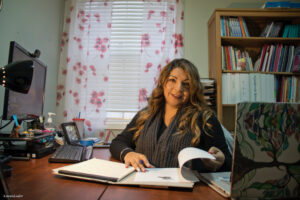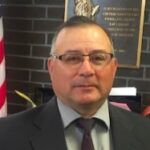by Natalie Hanson
posted Jan. 11
The COVID pandemic continues to impact California’s farmworkers and their access to health care -– particularly in more isolated rural zones like the Northern Sacramento Valley, doctors say.

The “tripledemic” — as flu and RSV add to the surging respiratory illnesses sweeping the nation -– may worsen existing barriers to health care access that marginalized communities face. In Butte County, health providers say it is hard to know which communities have been hit hardest by the virus, but they believe it is harder to reach essential worker communities like California’s farmworkers.
Nonprofit organizations have been working with local public health agencies to reach these communities, including “Promotores,” a program under Northern Valley Catholic Social Service. But there are ongoing struggles.
Program Manager Norma Lacy says she wants to see more local support for people facing financial as well as medical barriers -– especially if people fear deportation for seeking help.
“There are many suffering in silence,” she said. “One of the biggest barriers we dealt with was financial strain. Many were not able to get the stimulus,” Lacy added, referring to the payments made by the federal government, and later by the California governor, to relieve economic strain during the pandemic.
Ashley-Michelle Papon, who often works with Promotores through Migrant Clinicians Network, agreed that more support is needed to reach immigrants who often have a historic distrust of the medical system.
Papon sees up close how migrants who are “historically marginalized” in the workforce mistrust health care institutions that in the past may have conducted testing on people of color without their permission. That history of exploitation makes it difficult for workers to reach out for medical services, she said. And then, along came a pandemic.

“COVID has been such a polarizing issue, particularly as it relates to individuals of color and the labor force,” she said.
“We’d like to think that with three years in, it’s over because we’re over it -– but it very much isn’t over. But we’ve reached a point where everyone is so burnt out that we will never be able to effectively manage it.”
Experts weigh in
At a Dec. 21 Ethnic Media Services briefing, health care providers explained that farmworkers are among those most impacted by COVID. More than 500,000 people are employed in California’s massive agriculture industry where crowded housing and work sites combine with daily exposure to poor air quality and harmful pesticides. In 25 farmworker communities, infection rates remain about 2.5 times higher than the state average. And the rate of death from COVID among Latinos has been as much as 11% higher than the rate for all Californians.
Dr. Ilan Shapiro, AltaMed’s medical director of Health Education and Wellness, said the state knows doctors must be placed in communities most in need. California does not have enough doctors who are bilingual or culturally trained, and relies on community health workers to fill those gaps.
Noe Paramo, director of Sustainable Rural Communities Project of California Rural Legal Assistance Foundation, said UC Merced has interviewed many farmworkers and learned of gaps in testing and vaccines -– despite California’s “historic accomplishment” in expanding health care to undocumented people.

“The challenges still exist to get the vaccinations done and to farmworkers where they live and work,” Paramo said. “We do see an increase in farm workers wanting to get vaccinated.”
But retired researcher Ed Kissam — member of the National Advisory Council on Migrant Health -– said outreach to workers from farmers was “very uneven” in different counties. Some still “drag their feet,” he said. Only about half of farmworkers are vaccinated against COVID, making them disproportionately at risk for serious illness.
Kissam said he has hopes for utilizing the Biden Administration’s one-stop shopping approach -– locations that offer free testing and treatment and link people to providers. He said UC Davis hopes to reach people who typically wait to get medical care until they must seek help at an emergency room.

“However, there are major cost constraints and there have been big problems in that Republicans in Congress have opposed the administration’s request for COVID 19 funding,” he said. “Whether there will be funding for free tests for uninsured people and continued free vaccinations … is currently up in the air.”
Arcenio Lopez, community organizer for the Mixteco Indigena Community Organizing Project, also said the state must focus on getting community advocates who can work with indigenous farmworkers, equipped with cultural knowledge and language to combat mistrust of the health care system.
“We need to make sure that people who do agree to see a doctor find someone who can then speak their language,” he said.
Kissam said in an interview that UC Davis is developing the Center for Reducing Health Disparities in the Sacramento Valley, with plans to partner with Ampla Health and community based organizations and manage “Test To Treat” locations.
He said he thinks that as far as access to health care for farmworkers goes, “The Sacramento Valley gets ignored all too often.”
The Center’s goal is to meet people where they are, bring them options and supplies if needed. It should be operational early this year.
“The ideal is to have provisions, that if they can’t easily pick up things like prescriptions [they] can be delivered to their home,” he said.
In the next year, they expect to tackle challenges for workers like expanding free home testing to relieve the burden of clinical testing that many don’t have the time for. And Kissam hopes that people will get better messaging from the state around getting tested and accessing Paxlovid when they have symptoms, along with getting updated vaccines.
The Sacramento Valley works to keep up
In Butte County, COVID cases are still looking relatively low -– around six cases out of 100,000 people. It is uncertain if the same dramatic leap in cases last year, occurring just after the holidays, will be seen this year. (Early January 2022 saw the Omicron variant driving an average of 127 cases per 100,000 people).
However, doctors have advised that it is impossible to know the true number of cases due to the high number of people testing at home without reporting postive COVID results. They say it is also hard to parse the data to know which communities are seeing the most infections -– but they are concerned it will continue to be among essential workers like farmworkers.
In the Sacramento Valley, access to services is very mixed.
“Most of our outreach to the bilingual community has been through churches and community based organizations, in addition to providing several mobile vaccination clinics in those areas,” said Butte County Public Health communications coordinator Lisa Almaguer. She noted that public health ran an awareness campaign in Spanish and English to promote pediatric vaccines.
The department’s coordinator Erin Cox added that staffers have attended community events such as Día de los Muertos and Día del Campesino and work with organizations like the Hispanic Resource Council, Gridley Labor Housing, local restaurants, grocery stores, salons and schools to provide educational material on vaccines, test kits, and therapeutics.
Lacy said Promotores has been managing outreach among Butte County farmworkers for more than 10 years. It has a contract with the county’s behavioral health department to serve Latino and Hmong residents. All case managers are bilingual with Latino backgrounds.
“Our sole purpose is to remove the stigma of mental health services,” Lacy said. “We meet the families where they’re at.”
However, she also said aid extends to addressing food and financial insecurities, linking people to county services as well as health provider referrals.
Lacy said Promotores helped people get gift cards and food boxes, including people suffering from COVID who didn’t think they qualified for medical services. But those supports rely on donations, due to a lack of financial assistance for these communities.
Papon said the Network, which has a local office, also needs help from initiatives like Kissam’s UC Davis project to close service gaps. The Network has a limited imprint due to low funding and sparse local support and infrastructure.
There have been pockets of support from the community, including from Public Health workers and former Supervisor Debra Lucero.
“That support has been limited,” Papon said, “because of considerations that go well beyond what’s in the best interest of the community. That’s the cost of bureaucracy.”
“We have seen that when we make culturally-inclusive and bilingual information available, it is utilized, it is taken into account and we have improved health outcomes as a result,” she said.
Natalie Hanson is a contributor to ChicoSol.
